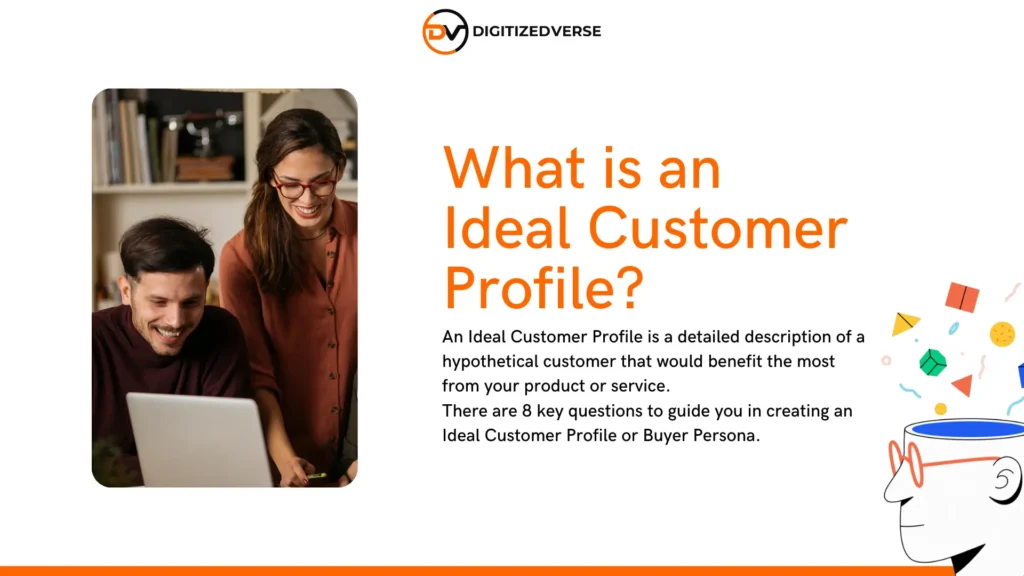In today’s competitive marketplace, understanding your customers is more important than ever. As an experienced digital marketer, I can tell you that crafting an Ideal Customer Profile (ICP) is the most critical step for winning advertising campaigns. Businesses that succeed are those that have a deep understanding of who their customers are, what they need, and how to meet those needs effectively. In this article, we’ll explore why your business needs an ICP and how you can craft one that drives growth and success.
What is an Ideal Customer Profile?
An Ideal Customer Profile is a detailed description of a hypothetical customer that would benefit the most from your product or service. Unlike buyer personas, which can be more generalized, an ICP focuses on the characteristics that make a customer the best fit for your business. This includes factors like the size of the company, industry, geographic location, and the specific challenges they face. By clearly defining your ideal customer, you can tailor your marketing, sales, and product development strategies to meet their needs.

Why is an Ideal Customer Profile Important?
Having a well-defined Ideal Customer Profile is crucial for several reasons:
- Focused Marketing Efforts: With an ICP, you can create targeted marketing campaigns that resonate with the customers who are most likely to convert. This leads to higher engagement rates and a better return on investment (ROI) for your marketing efforts.
- Improved Sales Efficiency: When your sales team knows exactly who they’re targeting, they can spend more time pursuing high-quality leads. This increases the efficiency of your sales process and shortens the sales cycle.
- Better Product Development: Understanding your ideal customer helps you create products and services that truly meet their needs. This leads to higher customer satisfaction and retention rates.
- Stronger Customer Relationships: By focusing on customers who are the best fit for your business, you can build stronger, long-lasting relationships. These customers are more likely to become repeat buyers and brand advocates.
- Enhanced Business Growth: Ultimately, a well-crafted ICP can drive business growth by ensuring that you’re attracting and retaining the right customers. This leads to sustainable growth and long-term success.
How to Craft an Ideal Customer Profile
Crafting an Ideal Customer Profile requires a deep understanding of your current customer base, as well as the market you’re operating in. Here are the steps to create an effective ICP:
1. Analyze Your Existing Customers
Start by looking at your current customers. Identify the ones that have been the most successful with your product or service. These are the customers who have stayed with you the longest, made the most purchases, or given you the highest satisfaction ratings. Analyze the characteristics they have in common, such as:
- Industry
- Company size
- Geographic location
- Budget
- Decision-making process
This analysis will give you a clear picture of who your ideal customers are.
2. Conduct Market Research
Market research is essential for understanding the broader landscape in which your business operates. Look at industry trends, competitive analysis, and customer feedback to identify common challenges and needs. This information will help you refine your Ideal Customer Profile and ensure that it aligns with the current market conditions.
3. Define Demographic and Firmographic Data
Demographics and firmographics are key components of an Ideal Customer Profile. Demographics include factors like age, gender, and income, while firmographics focus on company characteristics such as industry, size, and location. Defining these data points will help you create a more accurate and targeted ICP.
4. Identify Pain Points and Needs
Understanding the pain points and needs of your ideal customers is crucial for crafting an effective ICP. What challenges do they face in their industry? What solutions are they looking for? By identifying these pain points, you can position your product or service as the solution to their problems.
5. Map the Customer Journey
Mapping the customer journey involves understanding the steps your customers take from awareness to purchase. This includes the touchpoints they interact with, the questions they ask, and the objections they may have. By mapping the customer journey, you can identify key opportunities to engage with your ideal customers and guide them towards a purchase.
6. Gather Qualitative and Quantitative Data
To create a well-rounded Ideal Customer Profile, it’s important to gather both qualitative and quantitative data. Qualitative data includes customer interviews, surveys, and feedback, while quantitative data involves metrics like conversion rates, customer lifetime value, and purchase frequency. Combining these data types will give you a comprehensive understanding of your ideal customer.
7. Create a Detailed Customer Profile
Once you’ve gathered all the necessary data, it’s time to create a detailed Ideal Customer Profile. This profile should include the following components:
- Company Information: Industry, size, location, and revenue.
- Decision-Makers: Titles, roles, and responsibilities of key decision-makers.
- Pain Points: Specific challenges and needs that your product or service addresses.
- Goals and Objectives: What your ideal customers are trying to achieve.
- Behavioral Insights: How they interact with your brand and make purchasing decisions.
8. Validate and Refine Your ICP
After creating your Ideal Customer Profile, it’s important to validate it with real-world data. Test your ICP by targeting campaigns at this audience and analyzing the results. Are you seeing higher engagement rates? Are these customers converting at a higher rate? Use this feedback to refine and adjust your ICP as needed.
9. Align Your Teams Around the ICP
For an Ideal Customer Profile to be effective, it needs to be shared and understood across your organization. Ensure that your marketing, sales, and product development teams are all aligned around the same ICP. This will help create a cohesive strategy that drives better results.
10. Review and Update Regularly
Markets change, and so do customer needs. That’s why it’s important to review and update your Ideal Customer Profile regularly. Schedule regular check-ins to assess whether your ICP is still accurate and make adjustments as needed to stay aligned with your business goals.

Common Mistakes to Avoid When Crafting an Ideal Customer Profile
While creating an Ideal Customer Profile is essential for business success, there are some common mistakes that can hinder your efforts. Here are a few to watch out for:
1. Being Too Broad
One of the most common mistakes businesses make is creating an ICP that is too broad. While it may be tempting to target a wide audience, this can dilute your efforts and make it harder to connect with the right customers. Instead, focus on a specific segment that is most likely to benefit from your product or service.
2. Ignoring Customer Feedback
Customer feedback is a valuable source of information for crafting your Ideal Customer Profile. Ignoring this feedback can lead to a disconnect between your ICP and the actual needs of your customers. Make sure to incorporate customer insights into your profile to ensure it’s accurate and relevant.
3. Focusing Only on Demographics
While demographics are important, they are only one piece of the puzzle. Focusing solely on demographics can lead to an incomplete ICP. Be sure to include firmographics, psychographics, and behavioral data to create a more comprehensive profile.
4. Not Aligning Teams Around the ICP
An Ideal Customer Profile is only effective if it is used consistently across your organization. Failing to align your teams around the ICP can lead to mixed messaging and disjointed strategies. Make sure everyone is on the same page to maximize the impact of your ICP.
Conclusion
Creating an Ideal Customer Profile is a critical step in driving business growth and success. By understanding who your ideal customers are, what they need, and how to reach them, you can create targeted marketing and sales strategies that resonate and convert. Remember to analyze your existing customers, conduct market research, and gather both qualitative and quantitative data to create a comprehensive ICP. And most importantly, keep your Ideal Customer Profile up to date by regularly reviewing and refining it to stay aligned with market trends and customer needs. With a well-crafted ICP, your business will be well-positioned to attract and retain the customers that matter most.




